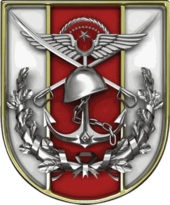
Back የቱርክ ወታደሮች Amharic القوات المسلحة التركية Arabic القوات المسلحة التركية ARZ Fuercies Armaes de Turquía AST Türkiyə Silahlı Qüvvələri Azerbaijani تورکیه سیلاحلی گوجلری AZB Узброеныя сілы Турцыі Byelorussian Въоръжени сили на Турция Bulgarian তুর্কি সশস্ত্র বাহিনী Bengali/Bangla Armeoù Turkia Breton
| Turkish Armed Forces | |
|---|---|
| Türk Silahlı Kuvvetleri (Turkish) | |
 Emblem of the Turkish Armed Forces | |
| Founded | 3 May 1920[a] |
| Service branches | |
| Headquarters | General Staff Building, Bakanlıklar, Çankaya, Ankara, Turkey |
| Website | https://www.tsk.tr |
| Leadership | |
| Commander-in-Chief | |
| Minister of National Defense | |
| Chief of the General Staff | |
| Personnel | |
| Military age | 20[3] |
| Conscription | 6 months |
| Active personnel | 355,200[4] |
| Reserve personnel | 378,700[4] |
| Expenditures | |
| Budget | US$15.8 billion (2023)[5] |
| Percent of GDP | 1.5% (2023)[6] |
| Industry | |
| Domestic suppliers | |
| Foreign suppliers | |
| Annual exports | $5.5 billion (2023)[7] |
| Related articles | |
| History | |
| Ranks | Military ranks of Turkey |
 |
| Leadership |
|---|
| Branches |
| History |
| Special Forces |
| Member of |
| Current foreign deployments and missions |
The Turkish Armed Forces (TAF; Turkish: Türk Silahlı Kuvvetleri, TSK) are the military forces of the Republic of Turkey. The Turkish Armed Forces consist of the Land Forces, the Naval Forces and the Air Forces. The Chief of the General Staff is the Commander of the Armed Forces. In wartime, the Chief of the General Staff acts as the Commander-in-Chief on behalf of the President, who represents the Supreme Military Command of the TAF on behalf of the Grand National Assembly of Turkey.[9] Coordinating the military relations of the TAF with other NATO member states and friendly states is the responsibility of the General Staff.
The history of the Turkish Armed Forces began with its formation after the collapse of the Ottoman Empire. The Turkish military perceived itself as the guardian of Kemalism, the official state ideology, especially of its emphasis on secularism. After becoming a member of NATO in 1952, Turkey initiated a comprehensive modernization program for its armed forces. The Turkish Army sent 14,936 troops to fight in the Korean War alongside South Korea and NATO. Towards the end of the 1980s, a second restructuring process was initiated. The Turkish Armed Forces participate in an EU Battlegroup under the control of the European Council, the Italian-Romanian-Turkish Battlegroup. The TAF also contributes operational staff to the Eurocorps multinational army corps initiative of the EU and NATO.
The Turkish Armed Forces is the second largest standing military force in NATO, after the U.S. Armed Forces.[10] Turkey is one of five NATO member states which are part of the nuclear sharing policy of the alliance, together with Belgium, Germany, Italy, and the Netherlands.[11] A total of 50 U.S. B61 nuclear bombs are hosted at the Incirlik Air Base, the most of the five countries.[12]
- ^ "TSK Official History Information". Turkish Armed Forces. Archived from the original on 29 June 2013. Retrieved 2 January 2014.
- ^ "Official Newspaper Turkey – Assignments" (PDF). resmigazete.gov.tr (in Turkish). Resmi Gazete. 4 June 2023. Retrieved 5 June 2023.
- ^ The Military Balance (2020 ed.). London: The International Institute for Strategic Studies. 14 February 2020. pp. 153–156. ISBN 978-0367466398.
- ^ a b International Institute for Strategic Studies (15 February 2023). The Military Balance 2023. London: Routledge. pp. 141–144. ISBN 9781032508955.
- ^ "SIPRI Fact Sheet - TRENDS IN WORLD MILITARY EXPENDITURE, 2023" (PDF). Stockholm International Peace Research Institute. April 2024. Archived from the original (PDF) on 22 April 2024. Retrieved 22 April 2024.
{{cite web}}:|archive-date=/|archive-url=timestamp mismatch; 23 April 2023 suggested (help) - ^ Tian, Nan; Fleurant, Aude; Kuimova, Alexandra; Wezeman, Pieter D.; Wezeman, Siemon T. (22 April 2023). "Trends in World Military Expenditure, 2023" (PDF). Stockholm International Peace Research Institute. Archived from the original on 22 April 2024. Retrieved 22 April 2024.
{{cite web}}:|archive-date=/|archive-url=timestamp mismatch; 25 April 2022 suggested (help) - ^ "Savunma ve havacılıktan 2023'te ihracat rekoru". 2 January 2024.
- ^ Cite error: The named reference
factbookwas invoked but never defined (see the help page). - ^ Federal Research Division, Turkey: A Country Study, Kessinger Publishing, 2004, ISBN 978-1-4191-9126-8, p. 337.
- ^ Husain, Amir. "Turkey Builds A Hyperwar Capable Military". Forbes. Retrieved 15 March 2024.
- ^ "Foreign Minister Wants US Nukes out of Germany". Der Spiegel. 30 March 2009. Archived from the original on 14 February 2012. Retrieved 1 November 2010.
- ^ "Nuclear Weapons: Who Has What at a Glance". www.armscontrol.org. Arms Control Association. Retrieved 16 December 2021.
Cite error: There are <ref group=lower-alpha> tags or {{efn}} templates on this page, but the references will not show without a {{reflist|group=lower-alpha}} template or {{notelist}} template (see the help page).
© MMXXIII Rich X Search. We shall prevail. All rights reserved. Rich X Search